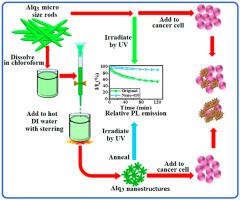当前位置:
X-MOL 学术
›
Mater. Chem. Phys.
›
论文详情
Our official English website, www.x-mol.net, welcomes your feedback! (Note: you will need to create a separate account there.)
Tunable fabrication of rice-like nanostructures aggregated into flowers of Alq3 with negligible photo-degradation for potential biomedical applications
Materials Chemistry and Physics ( IF 4.6 ) Pub Date : 2021-02-01 , DOI: 10.1016/j.matchemphys.2020.124080 Abdu Saeed , Numan Salah , Ahmed Alshahrie , Neazar Baghdadi , Kalamegam Gauthaman , Adnan Memic
Materials Chemistry and Physics ( IF 4.6 ) Pub Date : 2021-02-01 , DOI: 10.1016/j.matchemphys.2020.124080 Abdu Saeed , Numan Salah , Ahmed Alshahrie , Neazar Baghdadi , Kalamegam Gauthaman , Adnan Memic

|
Abstract Tris-(8-hydroxyquinoline) aluminum (Alq3) is a metal-organic semiconductor, widely used for organic light-emitting diodes (OLEDs) and devices. This material has unique optical properties that make it a promising material for broad medical applications. However, particle size might need to be reduced to the nanoscale to improve its performance and photostability. A simple, quick, and cost-effective approach to reducing the particle size from its micro powder to the nanoscale level is described in this work. Chloroform and water were used to produce uniform nanoparticles in a temperature range of 60–70 °C. The obtained results showed that the change in photoluminescence intensity of produced nanostructures with time (i.e., photo-degradation) was negligible. We showed that this is most likely to their facial structural state. This approach could be beneficial for developing stable OLEDs as well as for other potential applications. Finally, to assess the biomedical application potential of Alq3 in its micro/nano-size, we exposed them to the human colon cancer cell line (HCT116). Besides, we have utilized its fluorescence to track the degradation of gelatin-based hydrogel degradation. Cell cytotoxicity and morphology studies were carried out. We observed that the nanoparticles of Alq3 induce higher cytotoxic effects on the cells than the original Alq3 micro-sized powder. Also, the Alq3 nanoparticle showed excellently correlated to gelatin degradation. These results indicate the potential application of Alq3 in promising biomedical applications.
中文翻译:

可调谐制造聚集成 Alq3 花的类似水稻的纳米结构,光降解可忽略不计,用于潜在的生物医学应用
摘要 Tris-(8-羟基喹啉)铝(Alq3)是一种金属有机半导体,广泛用于有机发光二极管(OLED)和器件。这种材料具有独特的光学特性,使其成为具有广泛医疗应用前景的材料。然而,可能需要将粒径减小到纳米级以提高其性能和光稳定性。在这项工作中描述了一种简单、快速且具有成本效益的方法来将粒径从微粉减小到纳米级。氯仿和水用于在 60-70 °C 的温度范围内生产均匀的纳米颗粒。所得结果表明,所产生的纳米结构的光致发光强度随时间的变化(即光降解)可以忽略不计。我们表明这最有可能与他们的面部结构状态有关。这种方法可能有利于开发稳定的 OLED 以及其他潜在应用。最后,为了评估 Alq3 在其微/纳米尺寸的生物医学应用潜力,我们将它们暴露于人结肠癌细胞系 (HCT116)。此外,我们利用其荧光来跟踪基于明胶的水凝胶降解的降解。进行了细胞毒性和形态学研究。我们观察到 Alq3 的纳米颗粒比原始的 Alq3 微粉对细胞产生更高的细胞毒性作用。此外,Alq3 纳米颗粒显示出与明胶降解的极好相关性。这些结果表明 Alq3 在有前景的生物医学应用中的潜在应用。为了评估 Alq3 在其微/纳米尺寸的生物医学应用潜力,我们将它们暴露于人结肠癌细胞系 (HCT116)。此外,我们利用其荧光来跟踪基于明胶的水凝胶降解的降解。进行了细胞毒性和形态学研究。我们观察到 Alq3 的纳米颗粒比原始的 Alq3 微粉对细胞产生更高的细胞毒性作用。此外,Alq3 纳米颗粒显示出与明胶降解的极好相关性。这些结果表明 Alq3 在有前景的生物医学应用中的潜在应用。为了评估 Alq3 在其微/纳米尺寸的生物医学应用潜力,我们将它们暴露于人结肠癌细胞系 (HCT116)。此外,我们利用其荧光来跟踪基于明胶的水凝胶降解的降解。进行了细胞毒性和形态学研究。我们观察到 Alq3 的纳米颗粒比原始的 Alq3 微粉对细胞产生更高的细胞毒性作用。此外,Alq3 纳米颗粒显示出与明胶降解的极好相关性。这些结果表明 Alq3 在有前景的生物医学应用中的潜在应用。进行了细胞毒性和形态学研究。我们观察到 Alq3 的纳米颗粒比原始的 Alq3 微粉对细胞产生更高的细胞毒性作用。此外,Alq3 纳米颗粒显示出与明胶降解的极好相关性。这些结果表明 Alq3 在有前景的生物医学应用中的潜在应用。进行了细胞毒性和形态学研究。我们观察到 Alq3 的纳米颗粒比原始的 Alq3 微粉对细胞产生更高的细胞毒性作用。此外,Alq3 纳米颗粒显示出与明胶降解的极好相关性。这些结果表明 Alq3 在有前景的生物医学应用中的潜在应用。
更新日期:2021-02-01
中文翻译:

可调谐制造聚集成 Alq3 花的类似水稻的纳米结构,光降解可忽略不计,用于潜在的生物医学应用
摘要 Tris-(8-羟基喹啉)铝(Alq3)是一种金属有机半导体,广泛用于有机发光二极管(OLED)和器件。这种材料具有独特的光学特性,使其成为具有广泛医疗应用前景的材料。然而,可能需要将粒径减小到纳米级以提高其性能和光稳定性。在这项工作中描述了一种简单、快速且具有成本效益的方法来将粒径从微粉减小到纳米级。氯仿和水用于在 60-70 °C 的温度范围内生产均匀的纳米颗粒。所得结果表明,所产生的纳米结构的光致发光强度随时间的变化(即光降解)可以忽略不计。我们表明这最有可能与他们的面部结构状态有关。这种方法可能有利于开发稳定的 OLED 以及其他潜在应用。最后,为了评估 Alq3 在其微/纳米尺寸的生物医学应用潜力,我们将它们暴露于人结肠癌细胞系 (HCT116)。此外,我们利用其荧光来跟踪基于明胶的水凝胶降解的降解。进行了细胞毒性和形态学研究。我们观察到 Alq3 的纳米颗粒比原始的 Alq3 微粉对细胞产生更高的细胞毒性作用。此外,Alq3 纳米颗粒显示出与明胶降解的极好相关性。这些结果表明 Alq3 在有前景的生物医学应用中的潜在应用。为了评估 Alq3 在其微/纳米尺寸的生物医学应用潜力,我们将它们暴露于人结肠癌细胞系 (HCT116)。此外,我们利用其荧光来跟踪基于明胶的水凝胶降解的降解。进行了细胞毒性和形态学研究。我们观察到 Alq3 的纳米颗粒比原始的 Alq3 微粉对细胞产生更高的细胞毒性作用。此外,Alq3 纳米颗粒显示出与明胶降解的极好相关性。这些结果表明 Alq3 在有前景的生物医学应用中的潜在应用。为了评估 Alq3 在其微/纳米尺寸的生物医学应用潜力,我们将它们暴露于人结肠癌细胞系 (HCT116)。此外,我们利用其荧光来跟踪基于明胶的水凝胶降解的降解。进行了细胞毒性和形态学研究。我们观察到 Alq3 的纳米颗粒比原始的 Alq3 微粉对细胞产生更高的细胞毒性作用。此外,Alq3 纳米颗粒显示出与明胶降解的极好相关性。这些结果表明 Alq3 在有前景的生物医学应用中的潜在应用。进行了细胞毒性和形态学研究。我们观察到 Alq3 的纳米颗粒比原始的 Alq3 微粉对细胞产生更高的细胞毒性作用。此外,Alq3 纳米颗粒显示出与明胶降解的极好相关性。这些结果表明 Alq3 在有前景的生物医学应用中的潜在应用。进行了细胞毒性和形态学研究。我们观察到 Alq3 的纳米颗粒比原始的 Alq3 微粉对细胞产生更高的细胞毒性作用。此外,Alq3 纳米颗粒显示出与明胶降解的极好相关性。这些结果表明 Alq3 在有前景的生物医学应用中的潜在应用。



























 京公网安备 11010802027423号
京公网安备 11010802027423号